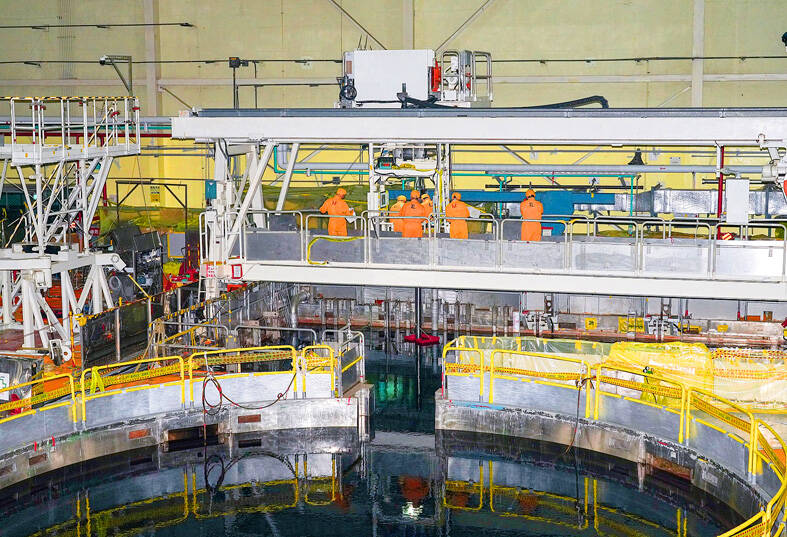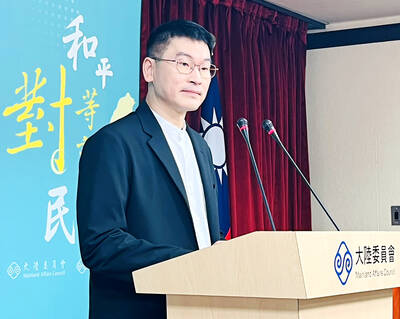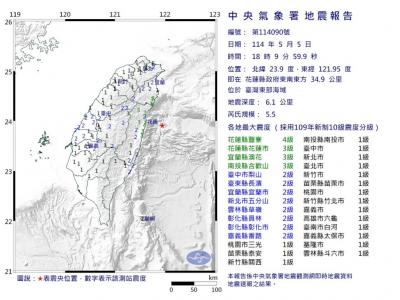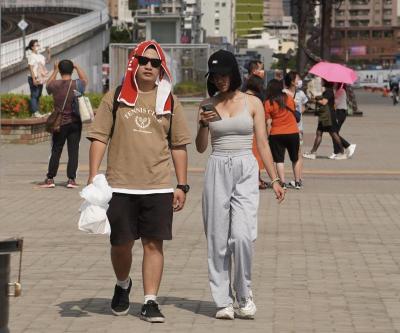The government could propose separate regulations for high-level radioactive nuclear waste to continue the use of nuclear energy, a source familiar with the matter said.
The reported proposals came as the nation’s three nuclear power plants are approaching their decommission dates.
Premier Cho Jung-tai (卓榮泰) in October said the government is “very open” to new nuclear power technology, which was widely perceived as a signal that it would soon revisit the Democratic Progressive Party’s long-standing goal of a “nuclear-free homeland.”

Photo courtesy of Taiwan Power Co
Nuclear waste disposal is one of the main reasons preventing the government from continuing the use of nuclear energy, as local governments were reluctant to have used radioactive materials stored within the limits of their administrative zones.
High-level radioactive nuclear waste refers to the fuel rods in nuclear reactors, whereas low-level radioactive waste refers to other spent nuclear fuel prepared for final disposal or residue produced by its reprocessing.
Currently, the government only has regulations for low-level radioactive waste. While the then-Atomic Energy Council, now the Nuclear Safety Commission, had in 2017 proposed regulations governing the disposal of high-level nuclear waste, the proposal was taken down within one week after it was announced to the public due to nationwide backlash.
Based on Taiwan Power Co’s (Taipower) plan to dispose of spent nuclear fuel, the review and approval of the sites that would be used to store nuclear waste should be completed by 2028, while geological investigations and tests of the sites, and establishment of an underground laboratory should be completed by 2029.
Sites suitable for nuclear waste are mostly located along the nation’s east coast and outlying islands along the west coast, as the base rock is mostly constituted of granite and crystalline limestone, a source familiar with the matter said.
The Ministry of Economic Affairs established an office in May to propose a separate regulation for high-level radioactive waste and to communicate with the public on the issue, which is scheduled to begin operations next year.
The regulations for high-level radioactive waste would be the office’s top priority despite challenges, because the ministry and New Taipei City have resolved differences of opinions on the storage of nuclear waste.
The draft regulations are likely to include compensation for local residents and the organization of referendums at sites chosen for low-level radioactive nuclear waste, a source said, adding that a policy committee formed by environmental groups, officials and experts would review storage sites after technical reviews.
The regulations were scheduled to be reviewed by the Executive Yuan in the third quarter this year, the ministry said.
Meanwhile, the government might reconsider the previous plan to build centralized storage facilities to accommodate nuclear waste stored on Orchid Island (Lanyu, 蘭嶼) if separate regulations for high-level radioactive and low-level radioactive waste are stipulated, the source said.
Prior to 1996, low-level radioactive nuclear waste was delivered to the outlying island off the east coast to be stored there. The practice stopped, as it was decided that high-level radioactive and low-level radioactive waste would be temporarily stored inside nuclear power plants.
The government had also agreed to relocate more than 100,000 barrels of nuclear waste on Orchid Island to a permanent disposition site, although it had difficulty finding such a location.
In 2019, the government agreed to budget a total NT$2.55 billion (US$77.9 million) as retroactive compensation to the residents of Orchid Island for accommodating the nuclear waste, with payments of NT$220 million being distributed every three years. Meanwhile, the Executive Yuan’s nuclear-free homeland team also agreed that centralized storage facilities should be built to accommodate nuclear waste stored in all three nuclear power plants and Orchid Island, with the project costing more than NT$60 billion.
However, the centralized storage facilities remain temporary facilities, which are designed to function for only 40 years.
Whether building such facilities is still necessary would be a question that the public needs to consider if the government plans to introduce regulations governing the disposal for high-level radioactive waste, the source said.

An essay competition jointly organized by a local writing society and a publisher affiliated with the Chinese Communist Party (CCP) might have contravened the Act Governing Relations Between the People of the Taiwan Area and the Mainland Area (臺灣地區與大陸地區人民關係條例), the Mainland Affairs Council (MAC) said on Thursday. “In this case, the partner organization is clearly an agency under the CCP’s Fujian Provincial Committee,” MAC Deputy Minister and spokesperson Liang Wen-chieh (梁文傑) said at a news briefing in Taipei. “It also involves bringing Taiwanese students to China with all-expenses-paid arrangements to attend award ceremonies and camps,” Liang said. Those two “characteristics” are typically sufficient

A magnitude 5.9 earthquake that struck about 33km off the coast of Hualien City was the "main shock" in a series of quakes in the area, with aftershocks expected over the next three days, the Central Weather Administration (CWA) said yesterday. Prior to the magnitude 5.9 quake shaking most of Taiwan at 6:53pm yesterday, six other earthquakes stronger than a magnitude of 4, starting with a magnitude 5.5 quake at 6:09pm, occurred in the area. CWA Seismological Center Director Wu Chien-fu (吳健富) confirmed that the quakes were all part of the same series and that the magnitude 5.5 temblor was

The brilliant blue waters, thick foliage and bucolic atmosphere on this seemingly idyllic archipelago deep in the Pacific Ocean belie the key role it now plays in a titanic geopolitical struggle. Palau is again on the front line as China, and the US and its allies prepare their forces in an intensifying contest for control over the Asia-Pacific region. The democratic nation of just 17,000 people hosts US-controlled airstrips and soon-to-be-completed radar installations that the US military describes as “critical” to monitoring vast swathes of water and airspace. It is also a key piece of the second island chain, a string of

The Central Weather Administration has issued a heat alert for southeastern Taiwan, warning of temperatures as high as 36°C today, while alerting some coastal areas of strong winds later in the day. Kaohsiung’s Neimen District (內門) and Pingtung County’s Neipu Township (內埔) are under an orange heat alert, which warns of temperatures as high as 36°C for three consecutive days, the CWA said, citing southwest winds. The heat would also extend to Tainan’s Nansi (楠西) and Yujing (玉井) districts, as well as Pingtung’s Gaoshu (高樹), Yanpu (鹽埔) and Majia (瑪家) townships, it said, forecasting highs of up to 36°C in those areas